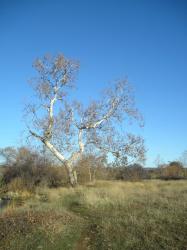Martin LeFevre: Jesus and Nature
Jesus and Nature

Two hundred meters downstream, on the bank of a creek that flows during winter and spring along the edge of town, sits a great sycamore. It’s home to a pair of kestrels, a small species of falcon that has one of the most beautiful flight patterns in nature.
A dirt path, overgrown with non-native thistle bushes--a nasty species with small spikes on the end that scratch bare skin and puncture bike tires--runs down to the creek from a paved bike path. But the spiky thistle plants provide a natural barrier for the home of the shy kestrels, limiting the number of humans willing to wade through the brush to get to the creek.
Recent rains have turned the dry season’s rock bed into a full-fledged stream again. I leave the bike beside the bike path, and push my way through the thistles to find, with incongruous and even disturbing beauty, a splash of orange poppies blooming beside the creek. In over 30 years in California’s Central Valley, I’ve never seen poppies blooming in December before.
I don’t see the kestrels until I stand, after an hour’s passive observation in the warmish sun, in a state of reverence and gratitude. As I begin walking back toward the bike, the pair of falcons alight the sycamore, and dance on the breeze directly overhead.
One playfully dives toward the other, which in turn arcs away with exquisite grace, its slender white wings glistening in the last full rays of the sun. They cavort like this for a minute, with the sense of performing before an appreciative audience of one, before one of the kestrels peels off toward the fields.
The lone falcon then flies a short distance away, and hovers for a full minute, its fluttering, rhythmically beating wings effortlessly holding it in place as the sharp-eyed predator searches the ground below for any movement of mice or other prey.
There is the feeling of not just witnessing something rare and stupendously beautiful, but of being, in that state of awareness, part of it in an ineffable way.
During the idolatry of consumption that is Christmas in North America, many people have begun to reflect on the total disconnect between Jesus’ teaching to and for the poor, and what Christianity has come to represent.
Jesus famously said a camel could easier pass through the eye of needle than the rich could get into heaven. But what is of greater interest, as Christianity crumbles under its own corrupted weight, is the question of Jesus’ relationship to nature.
Jesus often taught with images and analogies to nature. “The kingdom of God is like a mustard seed, which is smaller than any other seed; but when it is sown, it grows up and becomes the largest of shrubs, and puts forth large branches, so that the birds of the sky are able to make their nests in its shade.”
The depth and beauty of the imagery attest to a person who had a keen understanding of nature and of human nature. Jesus is saying that the small seed of intent can grow into a tremendous thing, even in this violent world, and give shelter to one and all.
How far such a sensitivity and sensibility is from the conservative Christian view that questions whether Nature actually deserves a religious response! Nature, to the ignorant and fearful, stands against humankind, for as a leading Christian columnist sadly proclaims, “humans aren’t at home amid the cruel rhythms of nature.”
Conflating, if not equating the problem of evil with nature, mediocre-minded Christians project their own tortured souls: “Nature is suffering and death. Its harmonies require violence.”
It is easy to rail against Hollywood pantheists, promoters of the “Avatar” of their imaginations. After all, the faddish worship of nature is also a retreat and reversion.
God is not synonymous with nature and the material universe. Rather, nature and the material universe are expressions of an infinite intelligence that permeates every atom and cell in the universe, but also inseparably extends beyond and before the cosmos.
The philosophical term for such a conception is panentheism. But the word and the conception is not the experiencing.
Anyone who has spent time alone in the wilderness knows that nature is both completely indifferent to us as separate selves, and completely enfolded within us as undivided individuals.
Jesus, whom evil overtook but did not break, spoke in the metaphors of his time, including “God the Father,” and “the kingdom of heaven.” But transcendence has the same timeless actuality--no matter what the words, or the age.
Nature is a mirror, and a reflection of an intelligence beyond thought and self. With self-knowing and complete silence, nature is also a portal to the dimension of fearless death, infinite creation, and sacred love.
- Martin LeFevre is a contemplative, and
non-academic religious and political philosopher. He has
been publishing in North America, Latin America, Africa, and
Europe (and now New Zealand) for 20 years. Email:
martinlefevre@sbcglobal.net. The author welcomes
comments.
ENDS


 Binoy Kampmark: Fencing The Ocean - Australia’s Social Media Safety Bill
Binoy Kampmark: Fencing The Ocean - Australia’s Social Media Safety Bill Binoy Kampmark: Trump, AUKUS And Australia’s Dim Servitors
Binoy Kampmark: Trump, AUKUS And Australia’s Dim Servitors Peter Dunne: Dunne's Weekly - The Wrong Answer To A Question That Does Not Exist
Peter Dunne: Dunne's Weekly - The Wrong Answer To A Question That Does Not Exist Martin LeFevre - Meditations: Perception, Conception And Beauty
Martin LeFevre - Meditations: Perception, Conception And Beauty Alastair Thompson: On The Publication Of The First NCQG Text 'New Collective Quantified Goal On Climate Finance'
Alastair Thompson: On The Publication Of The First NCQG Text 'New Collective Quantified Goal On Climate Finance' Ramzy Baroud: A Nation In Denial - Why Israel’s Defeat Is Imminent
Ramzy Baroud: A Nation In Denial - Why Israel’s Defeat Is Imminent